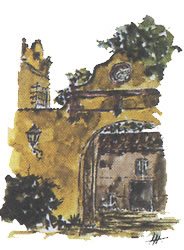Citrus tristeza virus (CTV) (Closteroviridae, Closterovirus, (+)ssRNA): Molecular diagnosis (RT-PCR).
Information 16/04/07.
The citrus tristeza virus (Citrus Tristeza virus -CTV-) is a species of the genus Closterovirus (family Closteroviridae), causing an economically important disease that affects such trees (citrus) worldwide virus where there are citrus crops. The name of the virus was given in several countries in South America for the demonstrations presented by the affected tree.
CTV is an elongated, thin flexible virus 2,000 nm long and 12 nm diameter, having a genome RNA positive stranded (+ ssRNA) with a capsid formed by two types of protein, greater capsid protein (CP : Capsid protein) of 25 kDa and minor protein CP. The major protein of 25 kDa has been used as an element for the development of several diagnostic methods (ELISA, hybridization, RT-PCR, Real-time RT-PCR, etc.). Single stranded RNA genome (ss), is the longest known, with 12 regions reading, which allows to encode at least 17 proteins. It also has two regions without translation (UTRs and 3'5': untranslated regions).
This virus occurs worldwide and infects many species of Citrus: Citrus aurantium and any infected species grafted feet of sour orange (Citrus aurantium) and Citrus sinensis, Citrus aurantifolia, Citrus reticulata, Citrus paradisi, ...).
The virus vector insects (mainly aphids) penetrating the phloem to extract sap is transmitted. Aphids are the main transmitters aphids brown citrus (toxoptera citricida), which are more restrictive in plant species that affect, and become winged forms to colonize new shoots. Other aphids are Aphis gossypii can transmit (melon aphid), Toxoptera aurantii (black citrus aphid) and Aphis spiraecola. Aphids, for infested, require at least 30 to 60 minutes supply to acquire the virus infected and remain at least 24 hours. It can also be transmitted with the cuttings used for grafting, or utensils used for pruning.
Affected trees have a highly variable symptoms depending on the species of the plant, the virulence of a virus strain and environmental conditions. The three main symptoms are: rapid decay in a few days, or slowly over months or years after the onset of symptoms (chlorotic leaves and generally regressive involvement), bites on the stem and yellowing of seedlings. The decay is observed in sweet oranges, mandarins and grapefruits when grafted on infected feet. The stems have bites leading to loss of vigor of the tree and fruit production, typical done when infected with virulent virus strains. Yellowing of seedlings, accompanied by growth regression preferably occurs in orange and lemon.
According to the signs of foot and stems of citrus, they have differentiated 5 main groups of strains of citrus tristeza virus: mild strain (M: Mild); strain venous clearance Mexican lime; strain yellowness seedlings (SY: Seeding Yellow) of orange, lemon and grapefruit; strains rapid decay (QD: Quick Declaine); and strains bite stems grapefruits and sweet orange (SP-G: Stem Pitting on grapefruit-G and SP-O: Pitting on sweet orange Stem).
The classic method of diagnosis was grafted foot lime (Citrus aurantifolia) with the diseased plant tissue, causing the involvement of the grafted plant being affected leaves show that clog vascularization, will become chlorotic and cupped. Another way of detecting is by ELISAs (enzyme-linked immunosorbent assay) to detect virus antigens or molecular methods to detect the virus genome.



